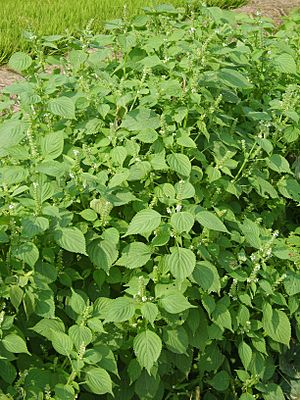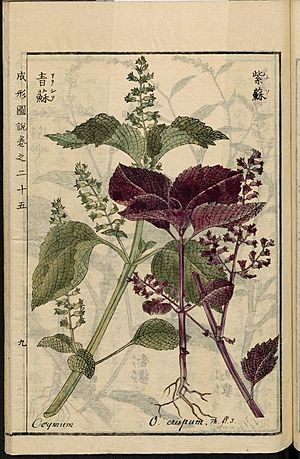Deulkkae facts for kids
Quick facts for kids Korean perilla |
|
|---|---|
 |
|
| perilla growing in Gimpo | |
| Scientific classification | |
| Genus: |
Perilla (plant)
|
| Species: |
frutescens
|
Perilla frutescens, often called perilla or Korean perilla, is a plant in the mint family. It grows every year and comes from Southeast Asia and the Indian highlands. People traditionally grow it in Korea, southern China, Japan, and India as a useful crop.
Perilla is an edible plant that you can grow in your garden. It has a strong, mint-like smell and attracts butterflies. A special type of this plant, called "shiso", is very popular in Japan. In the United States, perilla can grow like a weed and is harmful to cattle if they eat it.
Contents
What is Perilla Called?
This plant is commonly known as "perilla." It is also called Korean perilla because it is grown a lot and used often in Korean cuisine.
In the United States, where it grows wild, people call it by many names. Some of these names are perilla mint, beefsteak plant, purple perilla, and Chinese basil.
Types of Perilla
Perilla frutescens has three main types, also known as varieties:
- P. frutescens (var. frutescens): This is the most common type, called Korean perilla or deulkkae.
- P. frutescens var. crispa: This type is known as shiso or tía tô.
- P. frutescens var. hirtella: This one is sometimes called lemon perilla because of its scent.
How Perilla Looks
Perilla is a plant that grows about 60 to 90 centimeters (2 to 3 feet) tall. Its stems are square-shaped and a bit hairy.
The leaves grow opposite each other on the stem. They are about 7 to 12 cm (3 to 5 inches) long and 5 to 8 cm (2 to 3 inches) wide. They have an oval shape with pointy ends and jagged, saw-like edges. The leaves are usually green, but sometimes they have a touch of purple on the underside.
The flowers appear in late summer on long clusters called racemes. The flowers are small, about 4 to 5 millimeters (0.16 to 0.2 inches) long. After the flowers, small, round fruits grow, each about 2 mm (0.08 inches) wide. Perilla seeds can be white, grey, or brown. They are small and round, and about 1,000 seeds weigh 4 grams (0.14 ounces). These seeds contain a lot of oil, about 38-45% of their weight.
Growing Perilla
Perilla was brought to Korea a very long time ago, even before the Unified Silla era. Since then, it has been widely grown there.
Normally, perilla plants don't produce a lot of leaves or seeds. But if you cut the stem about 5 cm (2 inches) above the ground in summer, a new stem will grow. This new stem will produce more fruit. You can pick leaves from both the original stem and the new growth throughout summer and autumn.
The seeds are collected in autumn when they are ripe. To get the seeds, the whole plant is harvested. Then, the seeds are gently beaten out of the plant and spread out to dry in the sun.
Health Information and Safety
Different types of perilla are used in traditional medicine in Southeast Asia.
Perilla leaves have special natural compounds that give them their unique smell. Some of these compounds include perilla ketone and perillaldehyde. The "crispa" type of perilla has different leaf colors, from green to red to purple. This is because of natural colors called anthocyanins.
Even though people eat perilla, it can be harmful to animals like cattle, sheep, goats, and horses. If grazing cattle eat too much perilla, it can cause a serious breathing problem called "panting disease."
Possible Side Effects
Some people might get a skin rash if they touch the leaves or oil of perilla. Also, eating a very large amount of perilla seeds has caused serious allergic reactions in some cases.
How Nutritious is Perilla?
Perilla seeds are full of dietary fiber and important minerals like calcium and iron. They also contain protein and vitamins like niacin and thiamine. Perilla leaves are also very good for you, as they are rich in vitamins A, C, and riboflavin.
How Perilla is Used
In Cooking
East Asia
China
In Manchu cuisine, perilla leaves are used to make a dish called efen. These are steamed buns made from sticky rice flour dough. They are filled with sweet red bean paste and wrapped in perilla leaves. This dish is part of a traditional Manchu holiday.
Japan
In Japan, perilla is used less often than shiso (the crispa variety). In some parts of northeastern Japan, it's called jūnen, which means "ten years." People believed it could add ten years to a person's life! A local dish in Fukushima Prefecture called shingorō uses perilla. It's made of rice patties mixed with roasted and ground jūnen seeds and then grilled.
In the past, oil from perilla seeds was used in lamps. A famous warlord named Saitō Dōsan was once known as a seller of egoma (perilla) seed oil.
Korea
In Korean cuisine, perilla leaves, called kkaennip, are used a lot as a herb and vegetable. You can eat kkaennip fresh as a wrap, or cooked as a seasoned vegetable. It's also pickled in soy sauce or soybean paste to make jangajji (pickles) or kimchi.
Deulkkae, which are perilla seeds, are often toasted and ground into a powder called deulkkae-garu. They can also be pressed to make perilla oil. The toasted perilla powder is used to flavor soups, seasoned vegetable dishes, noodles, and even kimchi. It's also used as a topping for desserts like tteok (rice cakes). Perilla oil is used for cooking and as a seasoning.
Sometimes, in modern Korean-style Western food, perilla leaves are used instead of basil. The seed powder and oil are also used in salad dressings and dipping sauces. There's even a fancy restaurant in Seoul that serves vanilla ice cream with a secret ingredient: perilla oil!
South Asia
India
In India, perilla seeds are roasted and ground with salt, chilies, and tomatoes to make a tasty side dish or chutney. In the Kumaon division, the seeds are eaten raw, and the oil is used for cooking. The roasted seeds are also used to make a spicy chutney. People in northeast India also use perilla seeds and leaves to flavor curries. In Manipuri cuisine, the ground roasted seeds are used in a salad called 'singju'. The Khasis call it nei lieh and use its seeds in salads and meat dishes.
Nepal
In Nepal, perilla is known as silam. Just like in India, perilla seeds are roasted and ground with salt, chilies, and tomatoes to create a savory dip or chutney.
Perilla Seed Oil
Perilla oil has a special nutty smell and taste. It is pressed from toasted perilla seeds and used in Korean cooking to add flavor, as a seasoning, and for cooking. What's left after pressing the oil can be used as natural fertilizer or animal feed.
Images for kids
-
Perilla flowers
-
Perilla leaves
-
Perilla seeds
-
Kkaennip stir-fried in perilla oil
-
Kkaennip-jeon (pan-fried perilla leaves)
-
Kkaennip-bugak (deep-fried perilla leaves)
-
Kkaennip-jangajji (pickled perilla leaves)
-
Kkaennip-kimchi (perilla leaf kimchi)
-
Chueo-tang (loach soup) served with chopi and deulkkae (perilla seed) powder
-
Gamja-ongsimi (potato dough soup) boiled with deulkkae powder
-
Goguma-sun-deulkkae-muchim (sweet potato stems seasoned with deulkkae powder)
-
Perilla granita
See also
 In Spanish: Perilla frutescens para niños
In Spanish: Perilla frutescens para niños


















